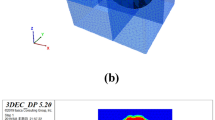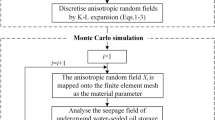Abstract
The permeability coefficient of rock mass is a critical parameter for groundwater flow analysis of underground water-sealed oil storages. Based on the site geological investigation, monitoring information, and data statistics, a method of determining representative permeability coefficients of original and grouted rock mass for underground water-sealed oil storage was proposed. Then, the proposed method was applied to the flow field analysis of an underground water-sealed oil storage under construction. The assessment of containment properties, the prediction of water inflow, and the analysis of grouting effect were carried out. For the similar kind of underground water-sealed oil storages, the geometric mean of the tested permeability coefficients was suggested to be the representative value of original rock mass. The relationship between the permeability reduction factors of grouting and the original permeability coefficients was obtained to predict the grouting zone permeability. Based on the proposed method, the representative original permeability coefficient of the storage zone is determined to be 1.96E−03 m/day, and the permeability coefficient of the grouted zone is conservatively suggested to be reduced to 10% of the original value. The predicted results of water inflow and grouting effect by flow simulation were compared with that by engineering analogy and theoretical analysis, which further verified the rationality of the proposed method and the reliability of the flow field analysis. The method of determining the representative permeability coefficients of rock mass and its application can help improve the accuracy of groundwater flow field analysis and offer guidelines for the construction of underground water-sealed oil storage.















Similar content being viewed by others
References
Akbulut S, Saglamer A (2003) Improvement of hydraulic conductivity of soils by grouting. Proc Inst Civ Eng-Gr 7(4):157–164. https://doi.org/10.1680/grim.7.4.157.37311
Bai J, Zhu Z, Liu R, Wang M, Zhang Q, Ma H (2021) Groundwater runoff pattern and keyhole grouting method in deep mines. Bull Eng Geol Environ 80:5743–5755. https://doi.org/10.1007/s10064-021-02102-y
BASF Construction Chemicals Europe Ltd (2011) Pre-excavation Grouting in Rock Tunneling. Chapter 11.3
Butrón C, Gustafson G, Fransson Å, Funehag J (2010) Drip sealing of tunnels in hard rock: a new concept for the design and evaluation of permeation grouting. Tunn Undergr Sp Tech 25(2):114–121. https://doi.org/10.1016/j.tust.2009.09.008
Cacas MC, Ledoux E, de Marsily G, Calmels P, Gaillard B, Margritta R (1990) Modeling fracture flow with a stochastic discrete fracture network: calibration and validation: 1. The flow model. Water Resour Res 26(3):479–489. https://doi.org/10.1016/0148-9062(90)92856-A
Cheng P, Zhao L, Li Q, Li L, Zhang S (2019) Water inflow prediction and grouting design for tunnel considering nonlinear hydraulic conductivity. KSCE J Civ Eng 23(9):1–9. https://doi.org/10.1007/s12205-019-0306-9
Distinguin M, Lavanchy JM (2007) Determination of hydraulic properties of the Callovo-Oxfordian argillite at the bure site: synthesis of the results obtained in deep boreholes using several in situ investigation techniques. Phys Chem Earth 32(1–7):379–392. https://doi.org/10.1016/j.pce.2006.02.056
Faramarzi L, Rasti A, Abtahi SM (2016) An experimental study of the effect of cement and chemical grouting on the improvement of the mechanical and hydraulic properties of alluvial formations. Constr Build Mater 126(15):32–43. https://doi.org/10.1016/j.conbuildmat.2016.09.006
Fu H, An P, Li K, Cheng G, Li J, Yu X (2020) Grouting design of rich water tunnels and the calculation of distance between annular blind pipes. Adv Civ Eng 2020:1–10. https://doi.org/10.1155/2020/8873971
General Institute of Water Conservancy and Hydropower Planning and Design, Ministry of Water Resources of the People’s Republic of China (2007) Specification for hydrogeological exploration of water resources and hydropower engineering. SL 373–2007. China Water & Power Press
Grøv E, Funehag J, Janson T (2014) Rock mass grouting in Sweden and Norway A matter of cultural differences or factual causes. Geotech News 32(1):41–51. https://doi.org/10.1002/bjs.4019
Gutjahr AL, Gelhar LW, Bakr AA, MacMillan JR (1978) Stochastic analysis of spatial variability in Subsurface flows 2. Evaluation and application. Water Resour Res 14(5):953–960. https://doi.org/10.1029/WR014i005p00953
Huang Z, Jiang Z, Zhu S, Qian Z, Cao D (2014) Characterizing the hydraulic conductivity of rock formations between deep coal and aquifers using injection tests. Int J Rock Mech Min 71:12–18. https://doi.org/10.1016/j.ijrmms.2014.06.017
Ishii E (2018) Assessment of hydraulic connectivity of fractures in mudstones by single-borehole investigations. Water Resour Res 54(5):3335–3356. https://doi.org/10.1029/2018WR022556
Ivars DM (2006) Water inflow into excavations in fractured rock—a three-dimensional hydro-mechanical numerical study. Int J Rock Mech Min 43(5):705–725. https://doi.org/10.1016/j.ijrmms.2005.11.009
Kipp KL (1985) Type curve analysis of inertial effects in the response of a well to a slug test. Water Resour Res 21(9):1397–1408. https://doi.org/10.1029/WR021i009p01397
Li S, Wang Z, Ping Y, Zhou Y, Zhang L (2014) Discrete element analysis of hydro-mechanical behavior of a pilot underground crude oil storage facility in granite in China. Tunn Undergr Sp Tech 40:75–84. https://doi.org/10.1016/j.tust.2013.09.010
Li P, Wang F, Long Y, Zhao X (2018) Investigation of steady water inflow into a subsea grouted tunnel. Tunn Undergr Sp Tech 80(OCT):92–102. https://doi.org/10.1016/j.tust.2018.06.003
Liu J, Chen W, Yuan J, Li C, Zhang Q, Li X (2018) Groundwater control and curtain grouting for tunnel construction in completely weathered granite. Bull Eng Geol Environ 77:515–531. https://doi.org/10.1007/s10064-017-1003-x
Liu Q, Zhao Z, Nie W, Sun J, Xiao F (2020) An analytical investigation on the estimation of water inflow into a circular tunnel based on-site data. Rock Mech Rock Eng 53(8):3835–3844. https://doi.org/10.1007/s00603-020-02114-2
Liu H, Qiao L, Wang S, Li W, Liu J, Wang Z (2021) Quantifying the containment efficiency of underground water-sealed oil storage caverns: Method and case study. Tunn Undergr Sp Tech 110(2):1–18. https://doi.org/10.1016/j.tust.2020.103797
Louis C, Maini YN (1970) Determination of in-situ hydraulic parameters in jointed rock. Int Soc Rock Mech Proc 1(1–32):235–245
Lu C, Li Z (2017) Rational permeability coefficient of a permeable lining for composite tunnel lining structures. Chin J Rock Mech Eng 36(8):1930–1938. https://doi.org/10.13722/j.cnki.jrme.2016.1442
Masset O, Loew S (2013) Quantitative hydraulic analysis of pre-drillings and inflows to the Gotthard Base tunnel (Sedrun Lot, Switzerland). Eng Geol 164:50–66. https://doi.org/10.1016/j.enggeo.2013.06.002
Nan Y (2015) Seepage field and permeability coefficient optimization of grouting circle for tunnel with high water pressure. Chin Build Waterproof 12:37–40 (In Chinese)
Pan Y, Luo Q, Zhou B, Chen J (2018) Analytical study on seepage field of deep tunnel with grouting circle in half plane. J Zhejiang U (Eng Sci) 52(6):1114–1122. https://doi.org/10.3785/j.issn.1008-973X.2018.06.010(In Chinese)
Park BY, Kim KS, Kwon S, Kim C, Bae DS, Hartley LJ, Lee HK (2002) Determination of the hydraulic conductivity components using a three-dimensional fracture network model in volcanic rock. Eng Geol 66(1):127–141. https://doi.org/10.1016/S0013-7952(02)00037-6
Piscopo V, Baiocchi A, Lotti F, Ayan EA, Biler AR, Ceyhan AH et al (2018) Estimation of rock mass permeability using variation in hydraulic conductivity with depth: experiences in hard rocks of western Turkey. Bull Eng Geol Environ 77(4):1663–1671. https://doi.org/10.1007/s10064-017-1058-8
Pozdniakov S, Tsang C (2004) A self-consistent approach for calculating the effective hydraulic conductivity of a binary, heterogeneous medium. Water Resour Res 40(5):1–13. https://doi.org/10.1029/2003WR002617
Rehfeldt KR, Boggs JM, Gelhar LW (1992) Field study of dispersion in a heterogeneous aquifer: 3. Geostatistical analysis of hydraulic conductivity. Water Resour Res 28(12):3309–3324. https://doi.org/10.1029/92WR01758
Ren S, Zhang Y, Yeh TCJ, Wang YL, Carr BJ (2021) Multiscale hydraulic conductivity characterization in a fractured granitic aquifer: the evaluation of scale effect. Water Resour Res 57:1–22. https://doi.org/10.1029/2020WR028482
Shin J, Hwang S, Jung SH, Han WS, Son J-S, Nam MJ, Kim T (2022) Development of site-scale conceptual model using Integrated Borehole methods: systematic Approach for hydraulic and geometric evaluation. Water 14:1336. https://doi.org/10.3390/w14091336
Sivapullaiah PV, Sridharan A, Stalin VK (2000) Hydraulic conductivity of bentonite-sand mixtures. Can Geotech J 37(37):406–413. https://doi.org/10.1139/t99-120
Tan L, Xiang W, Luo J, Liu Q, Zuo X (2020) Investigation of the models of flow through fractured rock masses based on borehole data. Adv Civ Eng 51–8. https://doi.org/10.1155/2020/4219847
Tani ME (2003) Circular tunnel in a semi-infinite aquifer. Tunn Undergr Sp Tech 18(1):49–55. https://doi.org/10.1016/S0886-7798(02)00102-5
Tani ME (2010) Helmholtz evolution of a semi-infinite aquifer drained by a circular tunnel. Tunn Undergr Sp Tech 25(1):54–62. https://doi.org/10.1016/j.tust.2009.08.005
Usmani A, Kannan G, Nanda A, Jain SK (2015) Seepage behavior and grouting effects for large rock caverns. Int J Geomech 15(3):06014023.1–06014023.7. https://doi.org/10.1061/(ASCE)GM.1943-5622.0000449
Wang Z, Li S, Qiao L (2015a) Assessment of hydro-mechanical behavior of a granite rock mass for a pilot underground crude oil storage facility in China. Rock Mech Rock Eng 48:2459–2472. https://doi.org/10.1007/s00603-015-0715-0
Wang Z, Li S, Qiao L (2015b) Design and test aspects of a water curtain system for underground oil storage caverns in China. Tunn Undergr Sp Tech 48:20–34. https://doi.org/10.1016/j.tust.2015.01.009
Wang Z, Li S, Qiao L, Zhang Q (2015c) Finite element analysis of the hydro-mechanical behavior of an underground crude oil storage facility in granite subject to cyclic loading during operation. Int J Rock Mech Min 73:70–81. https://doi.org/10.1016/j.ijrmms.2014.09.018
Wang Z, Kwon S, Qiao L, Bi L, Yu L (2017) Estimation of groundwater inflow into an underground oil storage facility in granite. Geomech Eng 12(6):1003–1020. https://doi.org/10.12989/gae.2017.12.6.1003
Wang Z, Liu J, Zhong S, Qiao L, Li W, Guo J (2023) Hydrogeological model for underground oil storage in rock caverns. Tunn Undergr Space Technol 132:104880. https://doi.org/10.1016/j.tust.2022.104880
Wilson CR, Witherspoon PA, Long JCS, Galbraith RM, DuBois AO, McPherson MJ (1983) Large-scale hydraulic conductivity measurements in fractured granite. Int J Rock Mech Min 20(6):269–276. https://doi.org/10.1016/0148-9062(83)90596-X
Xu Z, Zhao Z, Sun J, Lu M (2015) Determination of hydraulic conductivity of fractured rock masses: a case study for a rock cavern project in Singapore. J Rock Mech Geotech 7(2):178–184. https://doi.org/10.1016/j.jrmge.2014.10.006
Xu Z, Wang X, Li S, Gao B, Shi S, Xu X (2019) Parameter optimization for the thickness and hydraulic conductivity of tunnel lining and grouting rings. KSCE J Civ Eng 23(6):2772–2783. https://doi.org/10.1007/s12205-019-1509-9
Yang G, Wang X, Wang X, Wang X, Cao Y (2016) Analyses of seepage problems in a subsea tunnel considering effects of grouting and lining structure. Mar Georesour Geotec 34(1):65–70. https://doi.org/10.1080/1064119X.2014.958882
Zhang C, Zhang D, Ying Y, Luo J (2009) Analysis of grouting mechanism and its effect for karst tunneling in high water pressure and water-enriched region. Chin J Undergr Sp Eng 5(5):996–1002 (In Chinese)
Zhang QH, Liu QB, Su AJ, Li YJ, Zhang YH (2021) Hydraulic conductivity of rock masses surrounding water curtain boreholes for underground oil storage caverns. Energies 14:4588. https://doi.org/10.3390/en14154588
Funding
This work was supported by the National Natural Science Foundation of China (grant numbers 42177157); Applied Basic Research Program of Liaoning Province (grant numbers 2023JH2/101300153, 2022JH2/101300127); Science and Technology Program of Liaoning Province (grant numbers 2023JH1/10400003); and Shenyang Science and Technology Program (grant numbers 22-322-3-17, 23-407-3-25).
Author information
Authors and Affiliations
Corresponding author
Additional information
Publisher’s Note
Springer Nature remains neutral with regard to jurisdictional claims in published maps and institutional affiliations.
Rights and permissions
About this article
Cite this article
Qiao, L., Liu, J. & Wang, Z. Determining representative permeability coefficients of original and grouted rock mass for underground water-sealed oil storage: method and application. Bull Eng Geol Environ 83, 99 (2024). https://doi.org/10.1007/s10064-024-03593-1
Received:
Accepted:
Published:
DOI: https://doi.org/10.1007/s10064-024-03593-1




